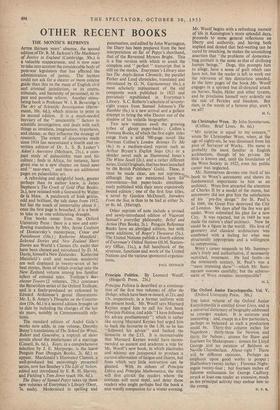Sir Christopher Wren. By John Summerson. (Collins. Brief Lives. 8s.
6d.) "MY surprise is equal to my concern," wrote Sir Christopher Wren, when, at the age of eighty-six, he was dismissed from his post of Surveyor of Works. His name is probably the most familiar in English architecture, though bf his private life little is known and, until the foundation of the Wren Society in 1923, even his public career was neglected.
Mr. Summerson devotes one third of his book to Wren's astronomy and shows its fundamental importance to him as an architect. Wren first attracted the attention • of Charles II by a model of the moon, but astronomy did not give him the satisfaction of his "pre-fire design" for St. Paul's. In 1666, the Great. Fire destroyed the City of London. Six days aftel the fire was got under, Wren submitted his plan for a new City. It was rejected, Wit in 1669 he was made the nation's chief architect. Now he could be a figure in the world. His love of geometry and classical architecture was combined with a feeling for what was structurally appropriate and a willingness to compromiSe.
Wren's career responds to Mr. Summer- son's lively and authoritative, if necessarily restricted, treatment. He had faults—to the nineteenth century, St. Paul's was a "mere imposing show"—which Mr. Sum- merson assesses carefully; but the achieve- ment of Wren remains: incomparable?
M. J.


































 Previous page
Previous page